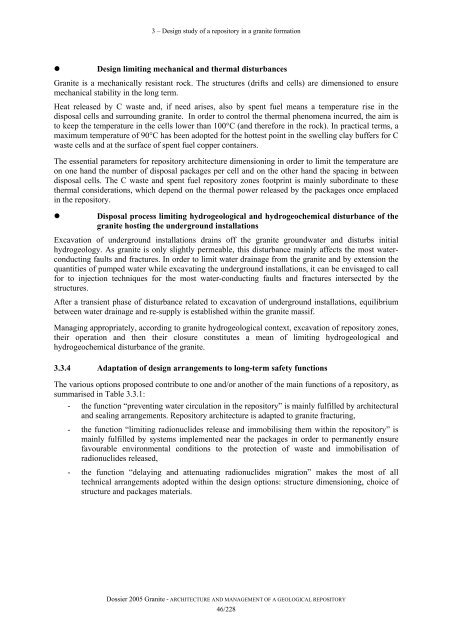Tome Architecture and management of a geological repository - Andra
Tome Architecture and management of a geological repository - Andra
Tome Architecture and management of a geological repository - Andra
You also want an ePaper? Increase the reach of your titles
YUMPU automatically turns print PDFs into web optimized ePapers that Google loves.
3 – Design study <strong>of</strong> a <strong>repository</strong> in a granite formation• Design limiting mechanical <strong>and</strong> thermal disturbancesGranite is a mechanically resistant rock. The structures (drifts <strong>and</strong> cells) are dimensioned to ensuremechanical stability in the long term.Heat released by C waste <strong>and</strong>, if need arises, also by spent fuel means a temperature rise in thedisposal cells <strong>and</strong> surrounding granite. In order to control the thermal phenomena incurred, the aim isto keep the temperature in the cells lower than 100°C (<strong>and</strong> therefore in the rock). In practical terms, amaximum temperature <strong>of</strong> 90°C has been adopted for the hottest point in the swelling clay buffers for Cwaste cells <strong>and</strong> at the surface <strong>of</strong> spent fuel copper containers.The essential parameters for <strong>repository</strong> architecture dimensioning in order to limit the temperature areon one h<strong>and</strong> the number <strong>of</strong> disposal packages per cell <strong>and</strong> on the other h<strong>and</strong> the spacing in betweendisposal cells. The C waste <strong>and</strong> spent fuel <strong>repository</strong> zones footprint is mainly subordinate to thesethermal considerations, which depend on the thermal power released by the packages once emplacedin the <strong>repository</strong>.• Disposal process limiting hydro<strong>geological</strong> <strong>and</strong> hydrogeochemical disturbance <strong>of</strong> thegranite hosting the underground installationsExcavation <strong>of</strong> underground installations drains <strong>of</strong>f the granite groundwater <strong>and</strong> disturbs initialhydrogeology. As granite is only slightly permeable, this disturbance mainly affects the most waterconductingfaults <strong>and</strong> fractures. In order to limit water drainage from the granite <strong>and</strong> by extension thequantities <strong>of</strong> pumped water while excavating the underground installations, it can be envisaged to callfor to injection techniques for the most water-conducting faults <strong>and</strong> fractures intersected by thestructures.After a transient phase <strong>of</strong> disturbance related to excavation <strong>of</strong> underground installations, equilibriumbetween water drainage <strong>and</strong> re-supply is established within the granite massif.Managing appropriately, according to granite hydro<strong>geological</strong> context, excavation <strong>of</strong> <strong>repository</strong> zones,their operation <strong>and</strong> then their closure constitutes a mean <strong>of</strong> limiting hydro<strong>geological</strong> <strong>and</strong>hydrogeochemical disturbance <strong>of</strong> the granite.3.3.4 Adaptation <strong>of</strong> design arrangements to long-term safety functionsThe various options proposed contribute to one <strong>and</strong>/or another <strong>of</strong> the main functions <strong>of</strong> a <strong>repository</strong>, assummarised in Table 3.3.1:- the function “preventing water circulation in the <strong>repository</strong>” is mainly fulfilled by architectural<strong>and</strong> sealing arrangements. Repository architecture is adapted to granite fracturing,- the function “limiting radionuclides release <strong>and</strong> immobilising them within the <strong>repository</strong>” ismainly fulfilled by systems implemented near the packages in order to permanently ensurefavourable environmental conditions to the protection <strong>of</strong> waste <strong>and</strong> immobilisation <strong>of</strong>radionuclides released,- the function “delaying <strong>and</strong> attenuating radionuclides migration” makes the most <strong>of</strong> alltechnical arrangements adopted within the design options: structure dimensioning, choice <strong>of</strong>structure <strong>and</strong> packages materials.Dossier 2005 Granite - ARCHITECTURE AND MANAGEMENT OF A GEOLOGICAL REPOSITORY46/228
















